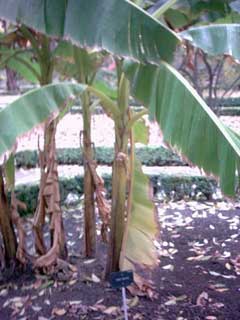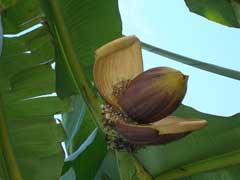 |
|
http://commons.wikimedia.org/wiki/User:Javier_martin |
 |
|
Translate this page:
Summary
Physical Characteristics

 Musa basjoo is an evergreen Perennial growing to 3 m (9ft) by 2 m (6ft).
Musa basjoo is an evergreen Perennial growing to 3 m (9ft) by 2 m (6ft).
See above for USDA hardiness. It is hardy to UK zone 8. It is in leaf all year. The species is monoecious (individual flowers are either male or female, but both sexes can be found on the same plant).
Suitable for: light (sandy), medium (loamy) and heavy (clay) soils and prefers well-drained soil. Suitable pH: mildly acid, neutral and basic (mildly alkaline) soils. It cannot grow in the shade. It prefers moist soil.
UK Hardiness Map
US Hardiness Map
Synonyms
M. japonica.
Plant Habitats
Woodland Garden Sunny Edge; Cultivated Beds; South Wall. By. West Wall. By.
Edible Uses
Edible Parts: Nectar
Edible Uses:
The nectar of the flowers is sweet and drinkable[183].
References More on Edible Uses
Medicinal Uses
Plants For A Future can not take any responsibility for any adverse effects from the use of plants. Always seek advice from a professional before using a plant medicinally.
Diuretic Febrifuge Sialagogue
The roots are diuretic, febrifuge and sialagogue[147]. A decoction is used in the treatment of beriberi, constipation, jaundice, dropsy, restlessness due to heat, leucorrhoea and croton bean poisoning[147, 218]. The leaves are diuretic[218].
References More on Medicinal Uses
The Bookshop: Edible Plant Books
Our Latest books on Perennial Plants For Food Forests and Permaculture Gardens in paperback or digital formats.

Edible Tropical Plants
Food Forest Plants for Hotter Conditions: 250+ Plants For Tropical Food Forests & Permaculture Gardens.
More

Edible Temperate Plants
Plants for Your Food Forest: 500 Plants for Temperate Food Forests & Permaculture Gardens.
More

More Books
PFAF have eight books available in paperback and digital formats. Browse the shop for more information.
Shop Now
Other Uses
Fibre
A fibre is obtained from the leaf stems[1, 11, 61]. Used for cloth, sails etc[46, 134]. The fibre can also be used for making paper[189] The leaves are harvested in summer and are soaked in water for 24 hours prior to cooking. The fibres are cooked for 2 hours with lye and then beaten in a ball mill for 4½ hours before being made into paper[189].
Special Uses
Carbon Farming
References More on Other Uses
Cultivation details
Industrial Crop: Fiber Management: Managed Multistem Regional Crop
Requires a rich soil and a sunny sheltered position[11, 166, 200]. The large leaves are very easily torn by the wind[233]. This species is only hardy in the milder areas of Britain and even there will require protection in colder winters[1]. It thrives and fruits in south-western Britain[11, 59] where it survived the very severe winters of 1985 to 1987[K]. Plants are herbaceous and die down after flowering, forming new shoots from the roots. Cultivated in Japan as a fibre plant[11].
Carbon Farming
-
Industrial Crop: Fiber
Clothing, rugs, sheets, blankets etc. Currently, almost none of our fiber are produced from perennial crops but could be!
-
Management: Managed Multistem
Regularly removing some multiple stems. A non-A non-destructive management systems maintaining the soil organic carbon.
-
Regional Crop
These crops have been domesticated and cultivated regionally but have not been adopted elsewhere and are typically not traded globally, Examples in this broad category include perennial cottons and many nuts and staple fruits.
References Carbon Farming Information and Carbon Sequestration Information
Temperature Converter
Type a value in the Celsius field to convert the value to Fahrenheit:
Fahrenheit:
The PFAF Bookshop
Plants For A Future have a number of books available in paperback and digital form. Book titles include Edible Plants, Edible Perennials, Edible Trees,Edible Shrubs, Woodland Gardening, and Temperate Food Forest Plants. Our new book is Food Forest Plants For Hotter Conditions (Tropical and Sub-Tropical).
Shop Now
Plant Propagation
Seed - best sown as soon as it is ripe in a warm greenhouse[134]. The seed usually germinates rapidly. Pre-soak stored seed for 72 hours in warm water, if it is still floating then it is not viable. Sow in a warm greenhouse in spring, planting one large seed in each pot. Germination usually takes place within 2 - 24 weeks at 22°c[134]. Grow the plants on in the greenhouse for at least 3 years before trying them outdoors. The seed remains viable for 2 years[134]. Removal of suckers as the plant comes into growth in spring.
Other Names
If available other names are mentioned here
Native Range
TEMPERATE ASIA: China (south)
Weed Potential
Right plant wrong place. We are currently updating this section.
Please note that a plant may be invasive in one area but may not in your area so it's worth checking.
Conservation Status
IUCN Red List of Threatened Plants Status :

Growth: S = slow M = medium F = fast. Soil: L = light (sandy) M = medium H = heavy (clay). pH: A = acid N = neutral B = basic (alkaline). Shade: F = full shade S = semi-shade N = no shade. Moisture: D = dry M = Moist We = wet Wa = water.
Now available:
Food Forest Plants for Mediterranean Conditions
350+ Perennial Plants For Mediterranean and Drier Food Forests and Permaculture Gardens.
[Paperback and eBook]
This is the third in Plants For A Future's series of plant guides for food forests tailored to
specific climate zones. Following volumes on temperate and tropical ecosystems, this book focuses
on species suited to Mediterranean conditions—regions with hot, dry summers and cool, wet winters,
often facing the added challenge of climate change.
Read More
Expert comment
Author
Siebold.&Zucc.
Botanical References
11200
Links / References
For a list of references used on this page please go here
Readers comment